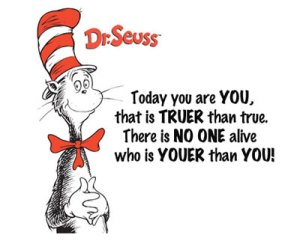“Freed of the burden of meaning, nonsense rhymes and the like reveal the internal structure of words as an object of interest rather than of labor.” (Johnston 48).
I loved this chapter, Johnston uses many good examples and one of them was about Dr. Seuss. Dr. Seuss figured out such a clever way of making children want to read the books. Growing up I loved reading Dr. Seuss because I felt and still do feel that those rhymes were/are full of fun and laughter. Its like reading a book out of this world because some of the words are simply just made up while others are real. That’s what makes it so fun. It made me feel that there is no type of “wrong” writing.
“Some children keep home and school spaces rigidly separate, believing they are unrelated.” (Johnston 43). I have to admit, I was this student. I couldn’t figure out how the same stuff we do at school relates to the stuff we do at home. I was finally able to answer myself. In school the teachers focus so much on way of reading, writing, and doing maths, but every one student is different, so as teachers we need to be able to really connect personally things at home into school. Teachers need to be able to focus less on the “right” and “wrong” way of doing something and focus more on the all the ways you can do something.
I had a teacher who always tried using personally experiences as examples to help us with our math problems and it was honestly the most helpful thing he could’ve done for us. He didn’t use a hypothetical situation or something magical that could never happened; he used real everyday examples. I remember one day he used a girls compact mirror as an example to measure the distance of an angle. It was so helpful for the exam because i just couldn’t get it out of my head the way he used it.



First of all, I LOVE your title. Second of all, I couldn’t agree with you more. You’re very lucky you had that teacher who used practical and relative examples to teach. I can remember thinking sometimes after listening to a teacher explain something, “…what did they just say?” It’s so important to have flexibility, and for the teachers to subliminally encourage it in their students. Johnston really gives us good examples of how to do this. Your Dr. Seuss story really spoke to me, because Dr. Seuss books are so playful and variable. His works help kids see all the possibilities in words and language, and you’re absolutely right–they do help kids feel as if there’s no wrong way of writing. Personally, I don’t think there is one either.
I absolutely agree with you about Dr. Seuss! I loved reading his books when I was younger and I still like to read them today. The teacher that you had sounds great because he helped making learning applicable. He helped it cross the gap from the classroom to everyday life, just like the shop keepers in Johnston’s story. When kids realize how learning translates to everyday life, it suddenly becomes a lot more interesting.
I love all of your visuals and how you always tell a personal story with each blog. I also love Dr. Seuss and think that children as well as adults can have fun reading his books.
I wrote my response on playful language and used the same Dr. Seuss picture and quote! Great minds must think alike, LoL.